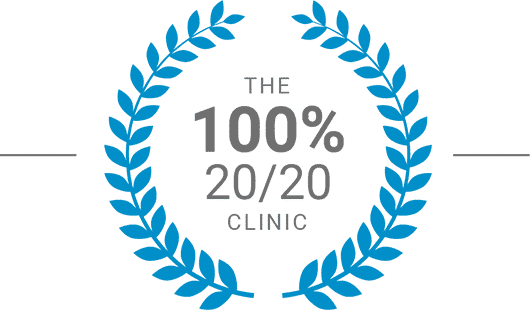Book Your Free Consultation
Mr David Allamby
MD, FRCOphth, FRCS
The two main reasons people wear glasses or contact lenses are myopia (nearsightedness) and hyperopia (farsightedness). However, being unable to focus on objects nearby or far away is only one issue that requires vision correction.
Astigmatism is a vision problem often found in conjunction with short-sight or long-sight, which causes blurred vision for both close-up and distant objects.
But what is astigmatism? What causes it, and what is available to you regarding astigmatism correction?
Astigmatism is one of several refractive errors characterised by blurry vision.
In an ideal eye, light rays pass through the natural lens and are reflected onto the retina, allowing the optic nerve to transmit visual information to the brain. A perfectly-shaped eye means light passes through the eye and is refracted normally.
However, an eye with astigmatism is misshapen, so light rays cannot be focused onto a single point on the retina.
If you believe that you may be astigmatic, there are several telltale signs - but an eye doctor is the only person who can diagnose astigmatism.
There are many reasons why an eye could be misshapen. Like many refractive errors, family history is a common cause of astigmatism.
Similarly, a history of eye disorders such as keratoconus (corneal thinning) or repeated eye surgery can cause astigmatism.
Astigmatism is a common condition among infants that typically resolves spontaneously by age one. Children with myopia (nearsightedness) or hyperopia (farsightedness) are more likely to develop astigmatism.
Interestingly, astigmatism affects Hispanic children at a higher incidence compared to other children.
Though it is all considered one condition, there are multiple types of astigmatism.
Corneal astigmatism is caused by a cornea shaped like a rugby ball (or American football) rather than being spherical like a ball. Light rays passing horizontally through the cornea will be focused at a different point than rays passing vertically.
This split focus is the hallmark of astigmatism and can be corrected by glasses or contact lenses.
Lenticular Astigmatism (Irregular Astigmatism)
A similar uneven curvature of the natural lens inside the eye causes lenticular astigmatism. In this case, the lens is more like a rugby ball than a football, while the cornea may be completely normal.
Like corneal astigmatism, it causes a split focus but can be corrected with glasses or contact lenses.
Irregular Astigmatism
A genuinely uneven cornea most commonly causes irregular astigmatism. The irregularities might be caused by scarring or previous surgery. Because the bumpiness is complex, it cannot be corrected by glasses or soft contact lenses.
Rigid contact lenses can be used to provide a new smooth front surface. Fortunately, this type of astigmatism is quite rare. Customised laser eye surgery can permanently remove the irregularities causing distorted vision.
Myopic astigmatism is found in an eye that is also affected by myopia. The eye focuses light in front of the retina, and the uneven focus further distorts vision.
Compound myopic astigmatism can be corrected by eyeglasses or contact lenses, which can treat astigmatism and myopia.
Refractive surgery, e.g. laser eye surgery, is a more popular treatment for compound astigmatism with myopia to provide a more permanent solution to these refractive errors.
Hyperopic astigmatism is found in an eye which is also affected by hyperopia. The eye focuses light behind the retina, and the misshapen cornea or lens leads to further distorted vision.
While eyeglasses and corrective lenses are popular methods of astigmatism management, surgical correction is often the preferable course of action for hyperopic astigmatism.
For the longest time, the only way to treat astigmatism was through glasses or contact lenses.
With the advent of safe and quick eye surgery methods, astigmatism correction and achieving clear vision have become easy and preferable for many patients.
LASIK (laser-assisted in situ keratomileusis) is the treatment of choice for astigmatism. 90% of Focus patients receive dual-laser advanced LASIK, and 10% undergo PRK (photorefractive keratectomy).
At Focus Clinics, we offer the unique A-LASIK procedure, which our chief surgeon, David Allamby, developed.
A high numerical aperture femtosecond laser creates a precise thin flap in the cornea. This laser is used for its highly accurate focus.
This flap exposes the underlying corneal tissue to allow the second laser to fix the eye, fixing your vision within 10 seconds.
The entire LASIK procedure treats almost 100% of vision problems within 5 minutes per eye.
Modern LASIK is a safe and highly effective treatment with very low risk to eye health - most patients report 20/20 visual acuity or higher after receiving LASIK refractive surgery, including those with astigmatism..
At Focus Clinics, we have extensive knowledge of using refractive surgery to treat astigmatism and nearsightedness, farsightedness, presbyopia, and cataract surgery.
If blurry vision, astigmatism, or corrective lenses or glasses are weighing you down, laser eye surgery may be the solution you've been looking for.
Focus Clinics has the answer to all forms of astigmatism treatment.
To book your free initial consultation with one of our experienced laser eye surgeons, contact us today through a quick online form.
Book a FREE* Consultation
To get a better idea of how we can help you, and also the different types of services we offer, book a consultation now.

100% 20/20 vision
Focus Clinic has a remarkable 100% success rate for 20/20 vision. We know of no other clinic that has matched these results. There is a big difference between, for example, 98% and 100% success, especially if you are in the 2%.

10 year guarantee
Your 10 Year Guarantee means you can return at any time if you have additional questions on the quality of your vision. If you have distance vision correction for short-sight then any repeat laser eye treatments to correct a return of myopia in the first 10 years are included free of charge.*

Most trusted eye treatment clinic
We have the highest trust rating of any ‘eye treatment’ rated clinic, according to independent review site TrustPilot. With an outstanding 9.9 out of 10, when it comes to your eyes, choose the clinic that actual patients trust the most.
*Terms and conditions apply, excludes any age-related changes and conditions unrelated to the primary treatment